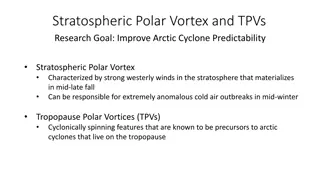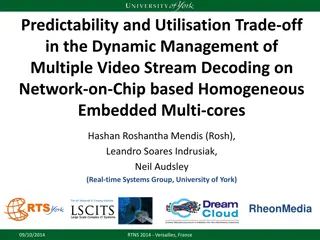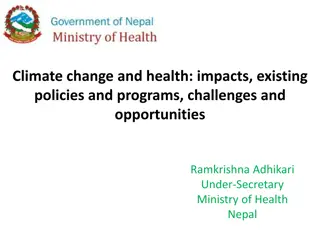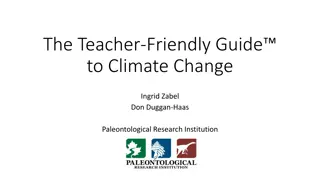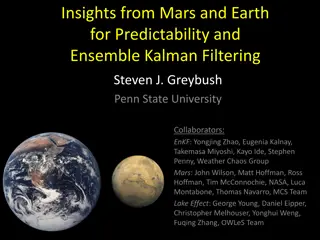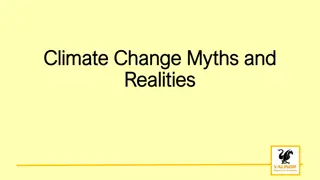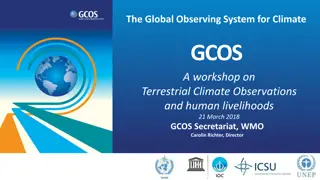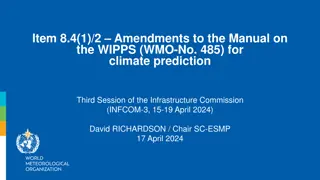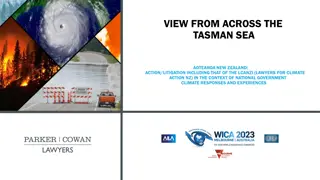Understanding Climate Predictability Challenges
Climate predictability is hindered by the chaotic nature of the atmosphere, making long-term climate predictions challenging despite advancements in weather forecasting technology. This lecture by Alan Robock explores the limitations of predictability due to initial conditions and system instabilities, using a simple equation to demonstrate the complexities of long-term climate prediction.
Download Presentation

Please find below an Image/Link to download the presentation.
The content on the website is provided AS IS for your information and personal use only. It may not be sold, licensed, or shared on other websites without obtaining consent from the author. Download presentation by click this link. If you encounter any issues during the download, it is possible that the publisher has removed the file from their server.
E N D
Presentation Transcript
Lecture 10, 10/6/14 Climate Dynamics 11:670:461 Alan Robock Department of Environmental Sciences Rutgers University, New Brunswick, New Jersey USA robock@envsci.rutgers.edu http://envsci.rutgers.edu/~robock
Predictability: How can we predict the climate decades into the future when we can t even predict the weather for next week? Predictability of the first kind: Predict the future based on initial conditions, with boundary conditions constant. This is limited by the chaotic nature of the atmosphere, which is a physical system with built-in instabilities, in vertical convection (e.g., thunderstorms) and horizontal motion (e.g., baroclinic instability - development of low pressure systems, such as hurricanes and Nor Easters). Alan Robock Department of Environmental Sciences
2 Xn+1 = a Xn - Xn X0 a 2.200 3.930 2.200 3.940 2.210 3.930 2.20 3.93 Consider a prediction using the above equation of the future state of the variable X, say the surface air temperature. The subscript n indicates the time, say the day, and a is a constant representing the physics of the climate system. X for any day is a times its value on the previous day minus X squared on the previous day. 6 2.197 2.948 7 3.807 2.924 8 0.468 2.971 9 1.620 2.879 10 3.742 3.055 11 0.703 2.704 12 2.269 3.342 13 3.769 1.999 14 0.607 3.880 15 2.017 0.233 16 3.859 0.864 17 0.274 2.658 18 1.002 3.408 19 2.934 1.813 20 2.922 3.856 Precision (decimal places) 3 3 3 2 Initial Conditions 2.210 3.801 0.490 1.686 3.783 0.556 1.876 3.853 0.297 1.079 3.076 2.627 3.423 1.735 3.808 0.465 1.611 3.736 0.725 2.324 3.732 n (Time Step) Control Physics Rounding 0 1 2 3 4 5 2.200 3.806 0.472 1.632 3.750 0.675 2.200 3.828 0.429 1.506 3.666 1.004 2.20 3.81 0.46 1.60 3.73 0.75 2.39 3.68 0.92 2.77 3.21 2.31 3.74 0.71 2.29 3.76 0.64 2.11 3.84 0.35 1.25 With such a simple equation, it should be possible to predict X indefinitely into the future. Right? Alan Robock Department of Environmental Sciences
2 Xn+1 = a Xn - Xn X0 a 2.200 3.930 2.200 3.940 2.210 3.930 2.20 3.93 Precision (decimal places) 3 3 3 2 Initial Conditions 2.210 3.801 0.490 1.686 3.783 0.556 1.876 3.853 0.297 1.079 3.076 2.627 3.423 1.735 3.808 0.465 1.611 3.736 0.725 2.324 3.732 n (Time Step) Control Physics Rounding 0 1 2 3 4 5 6 7 8 9 10 11 12 13 14 15 16 17 18 19 20 2.200 3.806 0.472 1.632 3.750 0.675 2.197 3.807 0.468 1.620 3.742 0.703 2.269 3.769 0.607 2.017 3.859 0.274 1.002 2.934 2.922 2.200 3.828 0.429 1.506 3.666 1.004 2.948 2.924 2.971 2.879 3.055 2.704 3.342 1.999 3.880 0.233 0.864 2.658 3.408 1.813 3.856 2.20 3.81 0.46 1.60 3.73 0.75 2.39 3.68 0.92 2.77 3.21 2.31 3.74 0.71 2.29 3.76 0.64 2.11 3.84 0.35 1.25 Let s assume that a is exactly 3.930 and that a prediction with three decimal places is the exact solution. Then let s consider three types of errors: imprecise knowledge of the physics of the climate system, imprecise initial conditions, and rounding due to limited computer resources. This example is from Edward Lorenz. Alan Robock Department of Environmental Sciences
2 Xn+1 = a Xn - Xn X0 a 2.200 3.930 2.200 3.940 2.210 3.930 2.20 3.93 Precision (decimal places) 3 3 3 2 Initial Conditions 2.210 3.801 0.490 1.686 3.783 0.556 1.876 3.853 0.297 1.079 3.076 2.627 3.423 1.735 3.808 0.465 1.611 3.736 0.725 2.324 3.732 n (Time Step) Control Physics Rounding 0 1 2 3 4 5 6 7 8 9 10 11 12 13 14 15 16 17 18 19 20 2.200 3.806 0.472 1.632 3.750 0.675 2.197 3.807 0.468 1.620 3.742 0.703 2.269 3.769 0.607 2.017 3.859 0.274 1.002 2.934 2.922 2.200 3.828 0.429 1.506 3.666 1.004 2.948 2.924 2.971 2.879 3.055 2.704 3.342 1.999 3.880 0.233 0.864 2.658 3.408 1.813 3.856 2.20 3.81 0.46 1.60 3.73 0.75 2.39 3.68 0.92 2.77 3.21 2.31 3.74 0.71 2.29 3.76 0.64 2.11 3.84 0.35 1.25 Alan Robock Department of Environmental Sciences
2 Xn+1 = a Xn - Xn X0 a 2.200 3.930 2.200 3.940 2.210 3.930 2.20 3.93 Precision (decimal places) 3 3 3 2 2 Initial Conditions 2.210 3.801 0.490 1.686 3.783 0.556 1.876 3.853 0.297 1.079 3.076 2.627 3.423 1.735 3.808 0.465 1.611 3.736 0.725 2.324 3.732 Control Xn+1 = a Xn - Xn n (Time Step) Physics Rounding 0 1 2 3 4 5 6 7 8 9 10 11 12 13 14 15 16 17 18 19 20 2.200 3.806 0.472 1.632 3.750 0.675 2.197 3.807 0.468 1.620 3.742 0.703 2.269 3.769 0.607 2.017 3.859 0.274 1.002 2.934 2.922 2.200 3.828 0.429 1.506 3.666 1.004 2.948 2.924 2.971 2.879 3.055 2.704 3.342 1.999 3.880 0.233 0.864 2.658 3.408 1.813 3.856 2.20 3.81 0.46 1.60 3.73 0.75 2.39 3.68 0.92 2.77 3.21 2.31 3.74 0.71 2.29 3.76 0.64 2.11 3.84 0.35 1.25 4.0 3.5 3.0 2.5 Xn 2.0 1.5 1.0 0.5 0.0 0 1 2 3 4 5 6 7 8 9 10 11 12 13 14 15 16 17 18 19 20 n Control Physics Initial Conditions Rounding Alan Robock Department of Environmental Sciences
Predictability: How can we predict the climate decades into the future when we can t even predict the weather for next week? Predictability of the second kind: Predict the future based on boundary conditions, independent of initial conditions. If there are slowly-varying (with respect to the atmospheric predictability limit of 2- 3 weeks) boundary conditions (e.g., greenhouse gases, stratospheric aerosols, sea surface temperatures, soil moisture, snow cover) that can be predicted, then the envelope of the weather can be predicted. [The first two examples are external to the climate system, and the last three are internal.] Alan Robock Department of Environmental Sciences
NOAA Medium Range Forecasts http://www.hpc.ncep.noaa.gov/medr/medr.shtml Alan Robock Department of Environmental Sciences
https://climatedataguide. ucar.edu/climate- data/era-interim Alan Robock Department of Environmental Sciences
ECMWF forecast skill http://www.ecmwf.int/products/forecasts/d/charts/medium/verification/timeseries/ccafadrian/ Alan Robock Department of Environmental Sciences
MJO forecast from Dee et al. (2011). Correlation of > 0.6 has skill. Dee, D. P., et al., 2011: The ERA-Interim reanalysis: configuration and performance of the data assimilation system. Q. J. R. Meteorol. Soc., 137, 553 597. DOI:10.1002/qj.828 Alan Robock Department of Environmental Sciences
NOAA MJO forecasts (1) Reanalysis 2 (R2) is used since CFS operational forecast utilizes the R2 as initialization data. (2) The indices for the latest 4 days are calculated using NCEP GDAS (Global Data Analysis System). (3) The MJO definition used here is identical to the Matt Wheeler's (Wheeler and Hendon 2004), i.e., to represent the MJO, the first two EOFs of combined fields of OLR, u850 and u200 are used. The followings are some details of the forecast models. (4) CFS operational: this is a 2003 version and two member ensemble mean is used. (5) GFS offline: this runs exactly the same as CFS operational model (e.g. the same R2 initial data) except that air-sea interaction is not allowed. Four member ensemble mean is used. (6) GFS operational: the model keeps being updated. Model climatology from the GFS offline model is used. The 11-member ensemble mean is used. (7) AR: Autoregressive time series model. (8) PCRLAG: Lagged multiple linear regression. For details please contact to Kyong-Hwan Seo (khseo@pusan.ac.kr). http://www.cpc.ncep.noaa.gov/products/people/wd52qz/mjoindex/description_methods_forecasts.html Alan Robock Department of Environmental Sciences
NOAA MJO forecast from GEFS model Alan Robock Department of Environmental Sciences http://www.cpc.ncep.noaa.gov/products/people/wd52qz/mjoindex/index/diagram_40days_forecast_GEFS_membera.gif
NOAA MJO forecast from statistical models Alan Robock Department of Environmental Sciences http://www.cpc.ncep.noaa.gov/products/people/wd52qz/mjoindex/index/diagram_40days_forecast.gif
ERA-Interim Persistence Dee, D. P., et al., 2011: The ERA-Interim reanalysis: configuration and performance of the data assimilation system. Q. J. R. Meteorol. Soc., 137, 553 597. DOI:10.1002/qj.828 Alan Robock Department of Environmental Sciences
CONSTRUCTED ANALOG METHOD, Huug van den Dool, http://www.cpc.ncep.noaa.gov/products/people/wd51hd/ Alan Robock Department of Environmental Sciences
http://www.ecmwf.int/products/forecasts/d/charts/seasonal/forecast/seasonal_range_forecast/http://www.ecmwf.int/products/forecasts/d/charts/seasonal/forecast/seasonal_range_forecast/ nino_plumes_public_s4!3.4!plumes!201310/ Alan Robock Department of Environmental Sciences
http://www.ecmwf.int/products/forecasts/d/charts/seasonal/forecast/seasonal_range_forecast/http://www.ecmwf.int/products/forecasts/d/charts/seasonal/forecast/seasonal_range_forecast/ nino_plumes_public_s4!3.4!plumes!201301/ Alan Robock Department of Environmental Sciences
http://www.ecmwf.int/products/forecasts/d/charts/seasonal/forecast/seasonal_range_forecast/http://www.ecmwf.int/products/forecasts/d/charts/seasonal/forecast/seasonal_range_forecast/ nino_plumes_public_s4!3.4!plumes!201208/ Alan Robock Department of Environmental Sciences
http://www.ecmwf.int/products/forecasts/d/charts/seasonal/forecast/seasonal_range_forecast/http://www.ecmwf.int/products/forecasts/d/charts/seasonal/forecast/seasonal_range_forecast/ nino_plumes_public_s4!3.4!plumes!201203/ Alan Robock Department of Environmental Sciences
http://www.ecmwf.int/products/forecasts/d/charts/seasonal/forecast/eurosip/nino_plumes_eurohttp://www.ecmwf.int/products/forecasts/d/charts/seasonal/forecast/eurosip/nino_plumes_euro _public!3.4!201309!/ Alan Robock Department of Environmental Sciences
http://www.ecmwf.int/products/forecasts/d/charts/seasonal/forecast/eurosip/nino_plumes_eurohttp://www.ecmwf.int/products/forecasts/d/charts/seasonal/forecast/eurosip/nino_plumes_euro _public!3.4!201301!/ Alan Robock Department of Environmental Sciences
http://www.ecmwf.int/products/forecasts/d/charts/seasonal/forecast/eurosip/nino_plumes_eurohttp://www.ecmwf.int/products/forecasts/d/charts/seasonal/forecast/eurosip/nino_plumes_euro _public!3.4!201208!/ Alan Robock Department of Environmental Sciences
http://www.ecmwf.int/products/forecasts/d/charts/seasonal/forecast/seasonal_range_forecast/http://www.ecmwf.int/products/forecasts/d/charts/seasonal/forecast/seasonal_range_forecast/ nino_plumes_public_s4!3.4!plumes!201208/ Alan Robock Department of Environmental Sciences
http://www.ecmwf.int/products/forecasts/d/charts/seasonal/forecast/eurosip/nino_plumes_eurohttp://www.ecmwf.int/products/forecasts/d/charts/seasonal/forecast/eurosip/nino_plumes_euro _public!3.4!201203!/ Alan Robock Department of Environmental Sciences












